Exploring the Link Between Technology and Social Isolation Today
VerifiedAdded on 2023/05/30
|12
|3760
|163
Essay
AI Summary
This essay examines the multifaceted relationship between technology and human social isolation. It begins by acknowledging the transformative influence of internet technologies on communication and community, contrasting the potential for fostering new connections with concerns about increased isolation and anomie. The essay discusses how technology can both create online relationships that substitute for interpersonal interactions and contribute to a decline in communication with family members, potentially leading to anxiety and depression. It further explores the concept of 'networked individualism,' where communities are formed through geographically dispersed social connections facilitated by technology. The essay also delves into the psychological aspects of technology use, including how individuals may turn to digital communication to escape reality or seek validation, which can exacerbate feelings of social isolation. The essay concludes by considering how technology can also be used to mitigate social isolation, particularly among vulnerable populations like senior citizens, by enabling domestic communication and fostering connections across distances.
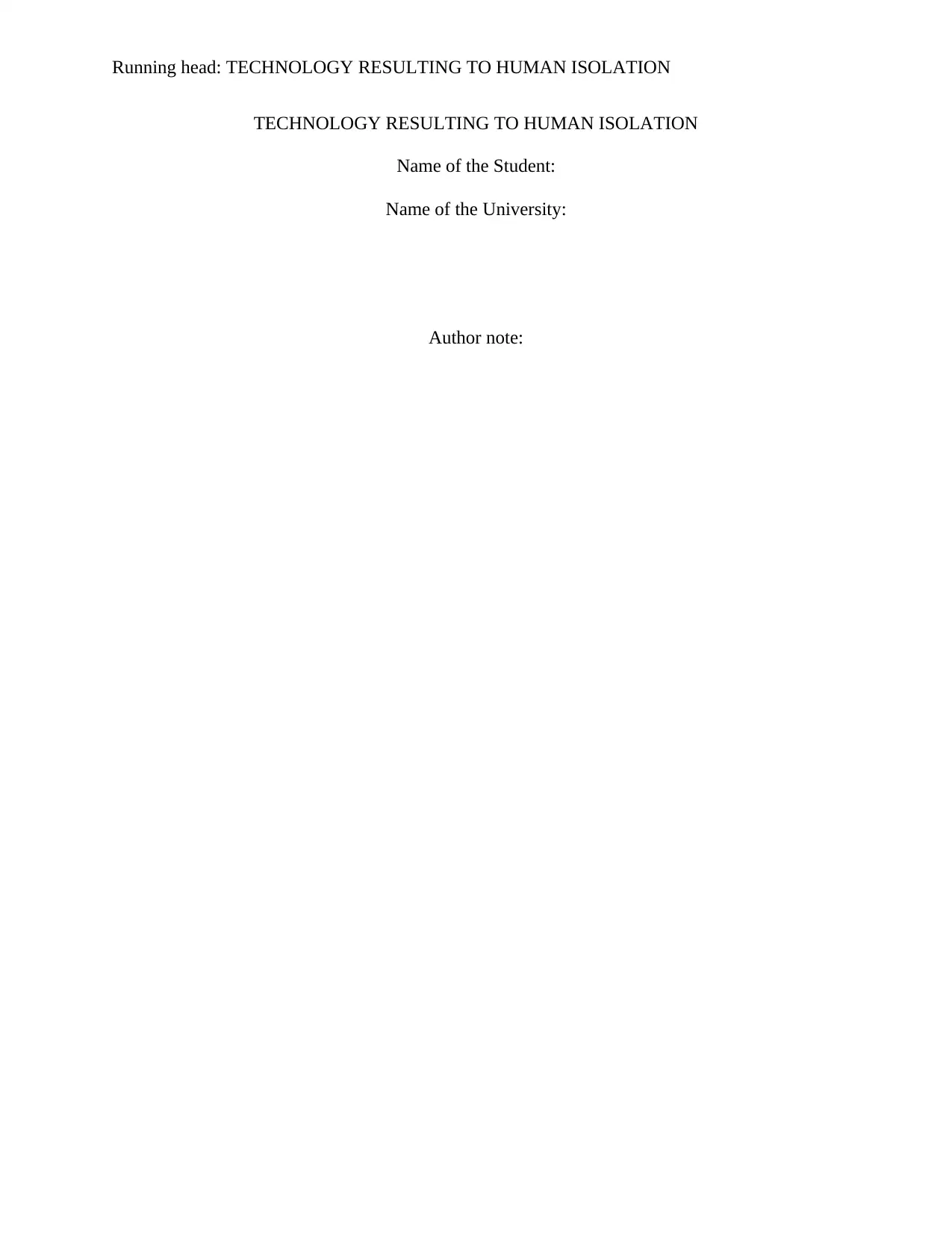
Running head: TECHNOLOGY RESULTING TO HUMAN ISOLATION
TECHNOLOGY RESULTING TO HUMAN ISOLATION
Name of the Student:
Name of the University:
Author note:
TECHNOLOGY RESULTING TO HUMAN ISOLATION
Name of the Student:
Name of the University:
Author note:
Paraphrase This Document
Need a fresh take? Get an instant paraphrase of this document with our AI Paraphraser
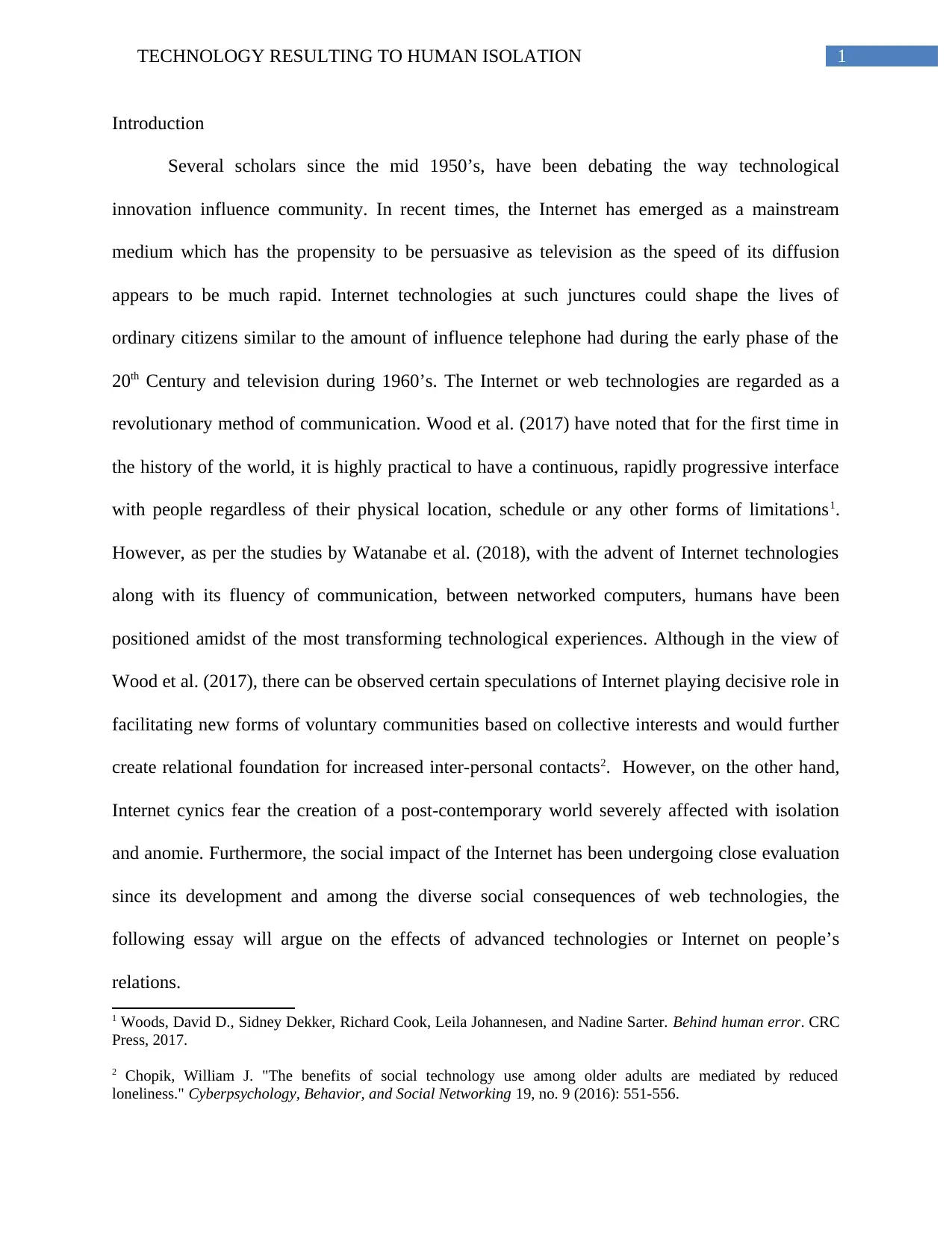
1TECHNOLOGY RESULTING TO HUMAN ISOLATION
Introduction
Several scholars since the mid 1950’s, have been debating the way technological
innovation influence community. In recent times, the Internet has emerged as a mainstream
medium which has the propensity to be persuasive as television as the speed of its diffusion
appears to be much rapid. Internet technologies at such junctures could shape the lives of
ordinary citizens similar to the amount of influence telephone had during the early phase of the
20th Century and television during 1960’s. The Internet or web technologies are regarded as a
revolutionary method of communication. Wood et al. (2017) have noted that for the first time in
the history of the world, it is highly practical to have a continuous, rapidly progressive interface
with people regardless of their physical location, schedule or any other forms of limitations1.
However, as per the studies by Watanabe et al. (2018), with the advent of Internet technologies
along with its fluency of communication, between networked computers, humans have been
positioned amidst of the most transforming technological experiences. Although in the view of
Wood et al. (2017), there can be observed certain speculations of Internet playing decisive role in
facilitating new forms of voluntary communities based on collective interests and would further
create relational foundation for increased inter-personal contacts2. However, on the other hand,
Internet cynics fear the creation of a post-contemporary world severely affected with isolation
and anomie. Furthermore, the social impact of the Internet has been undergoing close evaluation
since its development and among the diverse social consequences of web technologies, the
following essay will argue on the effects of advanced technologies or Internet on people’s
relations.
1 Woods, David D., Sidney Dekker, Richard Cook, Leila Johannesen, and Nadine Sarter. Behind human error. CRC
Press, 2017.
2 Chopik, William J. "The benefits of social technology use among older adults are mediated by reduced
loneliness." Cyberpsychology, Behavior, and Social Networking 19, no. 9 (2016): 551-556.
Introduction
Several scholars since the mid 1950’s, have been debating the way technological
innovation influence community. In recent times, the Internet has emerged as a mainstream
medium which has the propensity to be persuasive as television as the speed of its diffusion
appears to be much rapid. Internet technologies at such junctures could shape the lives of
ordinary citizens similar to the amount of influence telephone had during the early phase of the
20th Century and television during 1960’s. The Internet or web technologies are regarded as a
revolutionary method of communication. Wood et al. (2017) have noted that for the first time in
the history of the world, it is highly practical to have a continuous, rapidly progressive interface
with people regardless of their physical location, schedule or any other forms of limitations1.
However, as per the studies by Watanabe et al. (2018), with the advent of Internet technologies
along with its fluency of communication, between networked computers, humans have been
positioned amidst of the most transforming technological experiences. Although in the view of
Wood et al. (2017), there can be observed certain speculations of Internet playing decisive role in
facilitating new forms of voluntary communities based on collective interests and would further
create relational foundation for increased inter-personal contacts2. However, on the other hand,
Internet cynics fear the creation of a post-contemporary world severely affected with isolation
and anomie. Furthermore, the social impact of the Internet has been undergoing close evaluation
since its development and among the diverse social consequences of web technologies, the
following essay will argue on the effects of advanced technologies or Internet on people’s
relations.
1 Woods, David D., Sidney Dekker, Richard Cook, Leila Johannesen, and Nadine Sarter. Behind human error. CRC
Press, 2017.
2 Chopik, William J. "The benefits of social technology use among older adults are mediated by reduced
loneliness." Cyberpsychology, Behavior, and Social Networking 19, no. 9 (2016): 551-556.
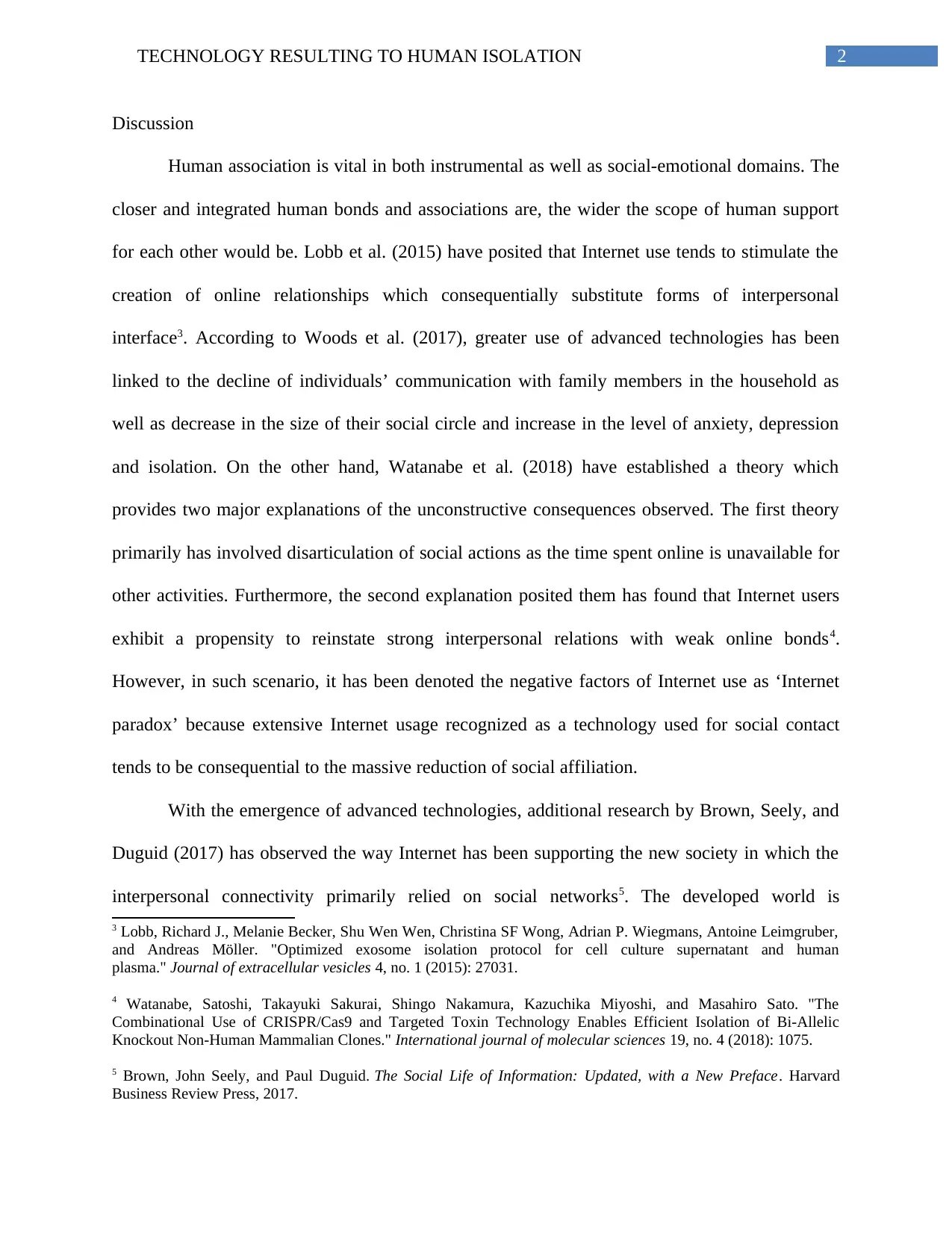
2TECHNOLOGY RESULTING TO HUMAN ISOLATION
Discussion
Human association is vital in both instrumental as well as social-emotional domains. The
closer and integrated human bonds and associations are, the wider the scope of human support
for each other would be. Lobb et al. (2015) have posited that Internet use tends to stimulate the
creation of online relationships which consequentially substitute forms of interpersonal
interface3. According to Woods et al. (2017), greater use of advanced technologies has been
linked to the decline of individuals’ communication with family members in the household as
well as decrease in the size of their social circle and increase in the level of anxiety, depression
and isolation. On the other hand, Watanabe et al. (2018) have established a theory which
provides two major explanations of the unconstructive consequences observed. The first theory
primarily has involved disarticulation of social actions as the time spent online is unavailable for
other activities. Furthermore, the second explanation posited them has found that Internet users
exhibit a propensity to reinstate strong interpersonal relations with weak online bonds4.
However, in such scenario, it has been denoted the negative factors of Internet use as ‘Internet
paradox’ because extensive Internet usage recognized as a technology used for social contact
tends to be consequential to the massive reduction of social affiliation.
With the emergence of advanced technologies, additional research by Brown, Seely, and
Duguid (2017) has observed the way Internet has been supporting the new society in which the
interpersonal connectivity primarily relied on social networks5. The developed world is
3 Lobb, Richard J., Melanie Becker, Shu Wen Wen, Christina SF Wong, Adrian P. Wiegmans, Antoine Leimgruber,
and Andreas Möller. "Optimized exosome isolation protocol for cell culture supernatant and human
plasma." Journal of extracellular vesicles 4, no. 1 (2015): 27031.
4 Watanabe, Satoshi, Takayuki Sakurai, Shingo Nakamura, Kazuchika Miyoshi, and Masahiro Sato. "The
Combinational Use of CRISPR/Cas9 and Targeted Toxin Technology Enables Efficient Isolation of Bi-Allelic
Knockout Non-Human Mammalian Clones." International journal of molecular sciences 19, no. 4 (2018): 1075.
5 Brown, John Seely, and Paul Duguid. The Social Life of Information: Updated, with a New Preface. Harvard
Business Review Press, 2017.
Discussion
Human association is vital in both instrumental as well as social-emotional domains. The
closer and integrated human bonds and associations are, the wider the scope of human support
for each other would be. Lobb et al. (2015) have posited that Internet use tends to stimulate the
creation of online relationships which consequentially substitute forms of interpersonal
interface3. According to Woods et al. (2017), greater use of advanced technologies has been
linked to the decline of individuals’ communication with family members in the household as
well as decrease in the size of their social circle and increase in the level of anxiety, depression
and isolation. On the other hand, Watanabe et al. (2018) have established a theory which
provides two major explanations of the unconstructive consequences observed. The first theory
primarily has involved disarticulation of social actions as the time spent online is unavailable for
other activities. Furthermore, the second explanation posited them has found that Internet users
exhibit a propensity to reinstate strong interpersonal relations with weak online bonds4.
However, in such scenario, it has been denoted the negative factors of Internet use as ‘Internet
paradox’ because extensive Internet usage recognized as a technology used for social contact
tends to be consequential to the massive reduction of social affiliation.
With the emergence of advanced technologies, additional research by Brown, Seely, and
Duguid (2017) has observed the way Internet has been supporting the new society in which the
interpersonal connectivity primarily relied on social networks5. The developed world is
3 Lobb, Richard J., Melanie Becker, Shu Wen Wen, Christina SF Wong, Adrian P. Wiegmans, Antoine Leimgruber,
and Andreas Möller. "Optimized exosome isolation protocol for cell culture supernatant and human
plasma." Journal of extracellular vesicles 4, no. 1 (2015): 27031.
4 Watanabe, Satoshi, Takayuki Sakurai, Shingo Nakamura, Kazuchika Miyoshi, and Masahiro Sato. "The
Combinational Use of CRISPR/Cas9 and Targeted Toxin Technology Enables Efficient Isolation of Bi-Allelic
Knockout Non-Human Mammalian Clones." International journal of molecular sciences 19, no. 4 (2018): 1075.
5 Brown, John Seely, and Paul Duguid. The Social Life of Information: Updated, with a New Preface. Harvard
Business Review Press, 2017.
⊘ This is a preview!⊘
Do you want full access?
Subscribe today to unlock all pages.

Trusted by 1+ million students worldwide
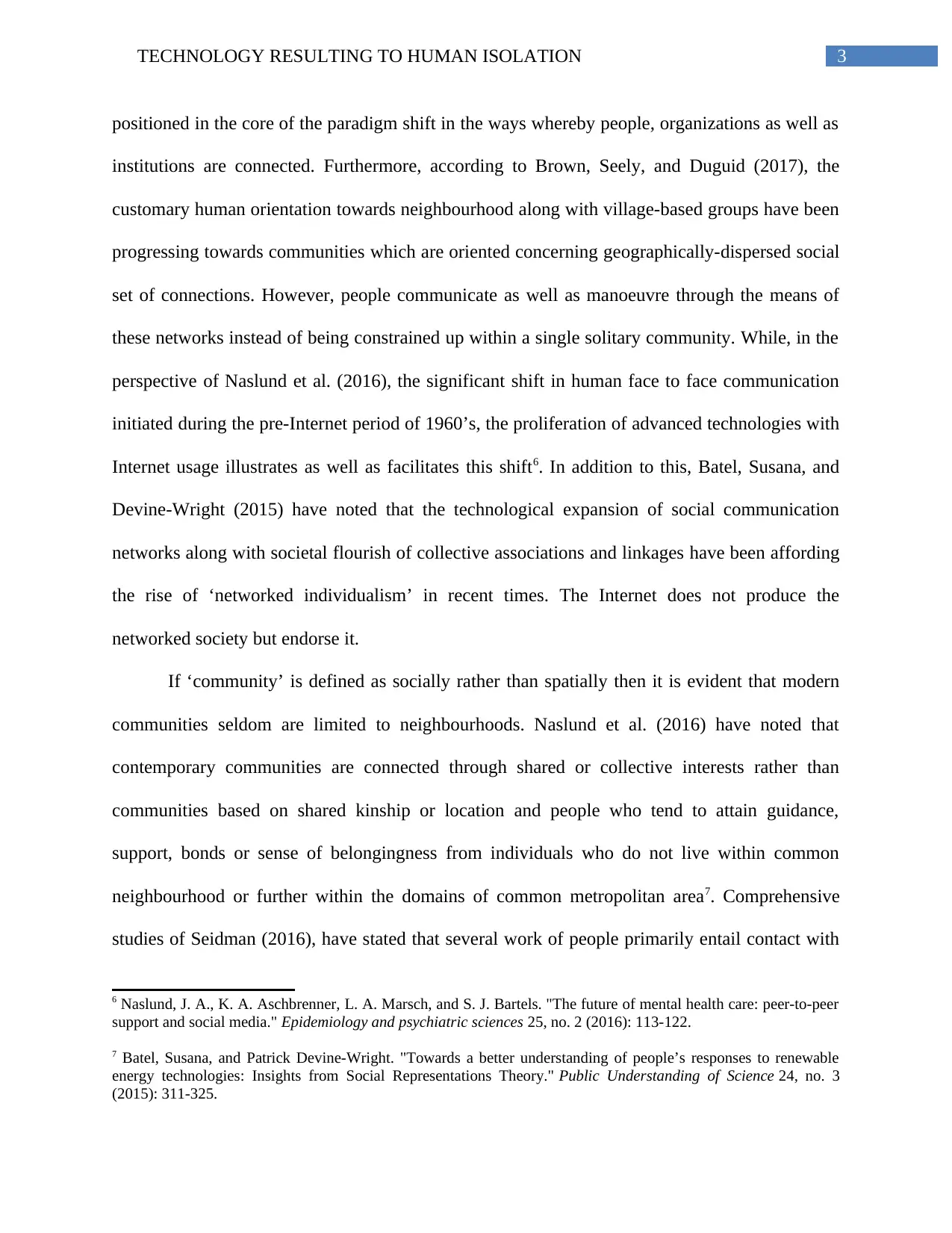
3TECHNOLOGY RESULTING TO HUMAN ISOLATION
positioned in the core of the paradigm shift in the ways whereby people, organizations as well as
institutions are connected. Furthermore, according to Brown, Seely, and Duguid (2017), the
customary human orientation towards neighbourhood along with village-based groups have been
progressing towards communities which are oriented concerning geographically-dispersed social
set of connections. However, people communicate as well as manoeuvre through the means of
these networks instead of being constrained up within a single solitary community. While, in the
perspective of Naslund et al. (2016), the significant shift in human face to face communication
initiated during the pre-Internet period of 1960’s, the proliferation of advanced technologies with
Internet usage illustrates as well as facilitates this shift6. In addition to this, Batel, Susana, and
Devine-Wright (2015) have noted that the technological expansion of social communication
networks along with societal flourish of collective associations and linkages have been affording
the rise of ‘networked individualism’ in recent times. The Internet does not produce the
networked society but endorse it.
If ‘community’ is defined as socially rather than spatially then it is evident that modern
communities seldom are limited to neighbourhoods. Naslund et al. (2016) have noted that
contemporary communities are connected through shared or collective interests rather than
communities based on shared kinship or location and people who tend to attain guidance,
support, bonds or sense of belongingness from individuals who do not live within common
neighbourhood or further within the domains of common metropolitan area7. Comprehensive
studies of Seidman (2016), have stated that several work of people primarily entail contact with
6 Naslund, J. A., K. A. Aschbrenner, L. A. Marsch, and S. J. Bartels. "The future of mental health care: peer-to-peer
support and social media." Epidemiology and psychiatric sciences 25, no. 2 (2016): 113-122.
7 Batel, Susana, and Patrick Devine-Wright. "Towards a better understanding of people’s responses to renewable
energy technologies: Insights from Social Representations Theory." Public Understanding of Science 24, no. 3
(2015): 311-325.
positioned in the core of the paradigm shift in the ways whereby people, organizations as well as
institutions are connected. Furthermore, according to Brown, Seely, and Duguid (2017), the
customary human orientation towards neighbourhood along with village-based groups have been
progressing towards communities which are oriented concerning geographically-dispersed social
set of connections. However, people communicate as well as manoeuvre through the means of
these networks instead of being constrained up within a single solitary community. While, in the
perspective of Naslund et al. (2016), the significant shift in human face to face communication
initiated during the pre-Internet period of 1960’s, the proliferation of advanced technologies with
Internet usage illustrates as well as facilitates this shift6. In addition to this, Batel, Susana, and
Devine-Wright (2015) have noted that the technological expansion of social communication
networks along with societal flourish of collective associations and linkages have been affording
the rise of ‘networked individualism’ in recent times. The Internet does not produce the
networked society but endorse it.
If ‘community’ is defined as socially rather than spatially then it is evident that modern
communities seldom are limited to neighbourhoods. Naslund et al. (2016) have noted that
contemporary communities are connected through shared or collective interests rather than
communities based on shared kinship or location and people who tend to attain guidance,
support, bonds or sense of belongingness from individuals who do not live within common
neighbourhood or further within the domains of common metropolitan area7. Comprehensive
studies of Seidman (2016), have stated that several work of people primarily entail contact with
6 Naslund, J. A., K. A. Aschbrenner, L. A. Marsch, and S. J. Bartels. "The future of mental health care: peer-to-peer
support and social media." Epidemiology and psychiatric sciences 25, no. 2 (2016): 113-122.
7 Batel, Susana, and Patrick Devine-Wright. "Towards a better understanding of people’s responses to renewable
energy technologies: Insights from Social Representations Theory." Public Understanding of Science 24, no. 3
(2015): 311-325.
Paraphrase This Document
Need a fresh take? Get an instant paraphrase of this document with our AI Paraphraser
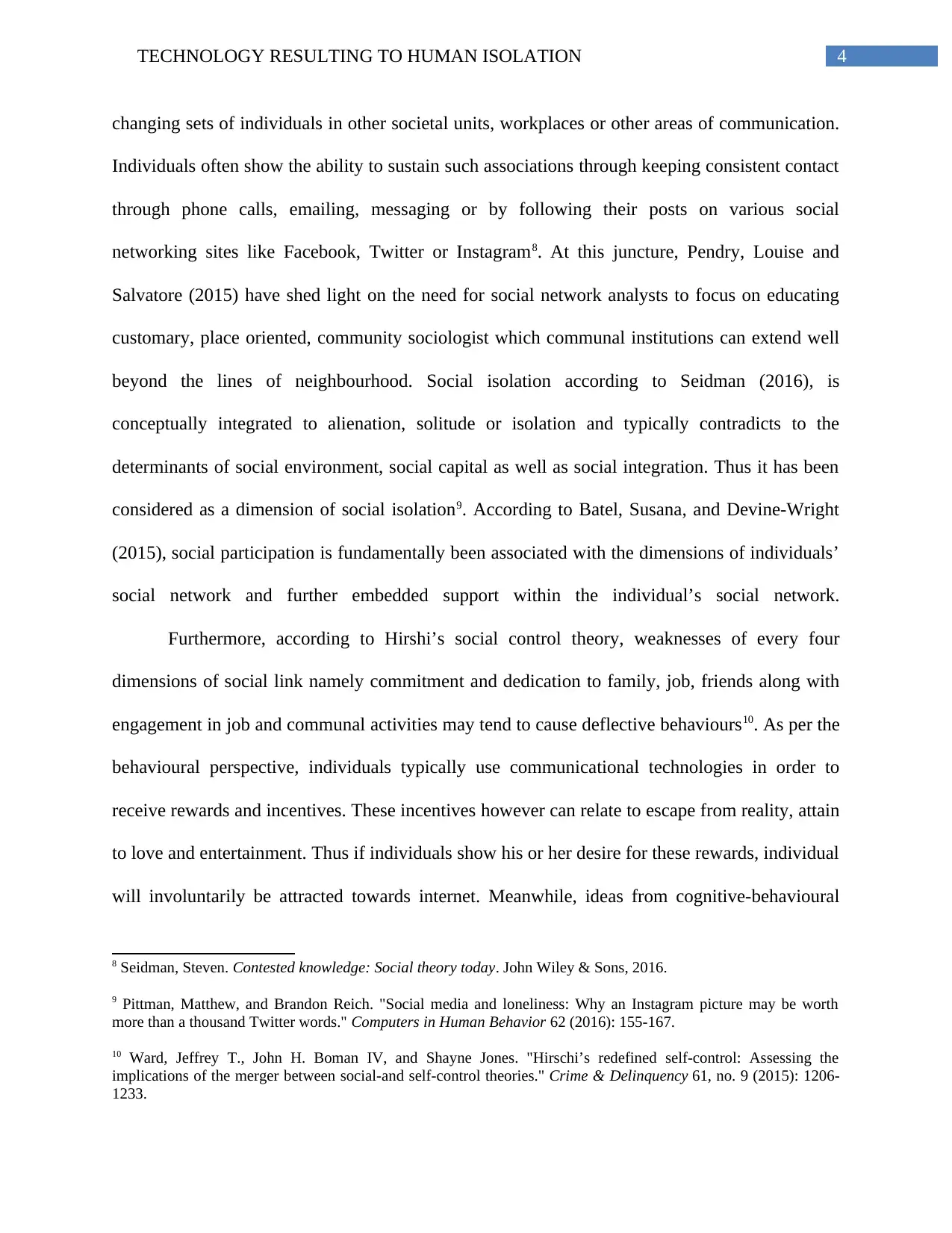
4TECHNOLOGY RESULTING TO HUMAN ISOLATION
changing sets of individuals in other societal units, workplaces or other areas of communication.
Individuals often show the ability to sustain such associations through keeping consistent contact
through phone calls, emailing, messaging or by following their posts on various social
networking sites like Facebook, Twitter or Instagram8. At this juncture, Pendry, Louise and
Salvatore (2015) have shed light on the need for social network analysts to focus on educating
customary, place oriented, community sociologist which communal institutions can extend well
beyond the lines of neighbourhood. Social isolation according to Seidman (2016), is
conceptually integrated to alienation, solitude or isolation and typically contradicts to the
determinants of social environment, social capital as well as social integration. Thus it has been
considered as a dimension of social isolation9. According to Batel, Susana, and Devine-Wright
(2015), social participation is fundamentally been associated with the dimensions of individuals’
social network and further embedded support within the individual’s social network.
Furthermore, according to Hirshi’s social control theory, weaknesses of every four
dimensions of social link namely commitment and dedication to family, job, friends along with
engagement in job and communal activities may tend to cause deflective behaviours10. As per the
behavioural perspective, individuals typically use communicational technologies in order to
receive rewards and incentives. These incentives however can relate to escape from reality, attain
to love and entertainment. Thus if individuals show his or her desire for these rewards, individual
will involuntarily be attracted towards internet. Meanwhile, ideas from cognitive-behavioural
8 Seidman, Steven. Contested knowledge: Social theory today. John Wiley & Sons, 2016.
9 Pittman, Matthew, and Brandon Reich. "Social media and loneliness: Why an Instagram picture may be worth
more than a thousand Twitter words." Computers in Human Behavior 62 (2016): 155-167.
10 Ward, Jeffrey T., John H. Boman IV, and Shayne Jones. "Hirschi’s redefined self-control: Assessing the
implications of the merger between social-and self-control theories." Crime & Delinquency 61, no. 9 (2015): 1206-
1233.
changing sets of individuals in other societal units, workplaces or other areas of communication.
Individuals often show the ability to sustain such associations through keeping consistent contact
through phone calls, emailing, messaging or by following their posts on various social
networking sites like Facebook, Twitter or Instagram8. At this juncture, Pendry, Louise and
Salvatore (2015) have shed light on the need for social network analysts to focus on educating
customary, place oriented, community sociologist which communal institutions can extend well
beyond the lines of neighbourhood. Social isolation according to Seidman (2016), is
conceptually integrated to alienation, solitude or isolation and typically contradicts to the
determinants of social environment, social capital as well as social integration. Thus it has been
considered as a dimension of social isolation9. According to Batel, Susana, and Devine-Wright
(2015), social participation is fundamentally been associated with the dimensions of individuals’
social network and further embedded support within the individual’s social network.
Furthermore, according to Hirshi’s social control theory, weaknesses of every four
dimensions of social link namely commitment and dedication to family, job, friends along with
engagement in job and communal activities may tend to cause deflective behaviours10. As per the
behavioural perspective, individuals typically use communicational technologies in order to
receive rewards and incentives. These incentives however can relate to escape from reality, attain
to love and entertainment. Thus if individuals show his or her desire for these rewards, individual
will involuntarily be attracted towards internet. Meanwhile, ideas from cognitive-behavioural
8 Seidman, Steven. Contested knowledge: Social theory today. John Wiley & Sons, 2016.
9 Pittman, Matthew, and Brandon Reich. "Social media and loneliness: Why an Instagram picture may be worth
more than a thousand Twitter words." Computers in Human Behavior 62 (2016): 155-167.
10 Ward, Jeffrey T., John H. Boman IV, and Shayne Jones. "Hirschi’s redefined self-control: Assessing the
implications of the merger between social-and self-control theories." Crime & Delinquency 61, no. 9 (2015): 1206-
1233.
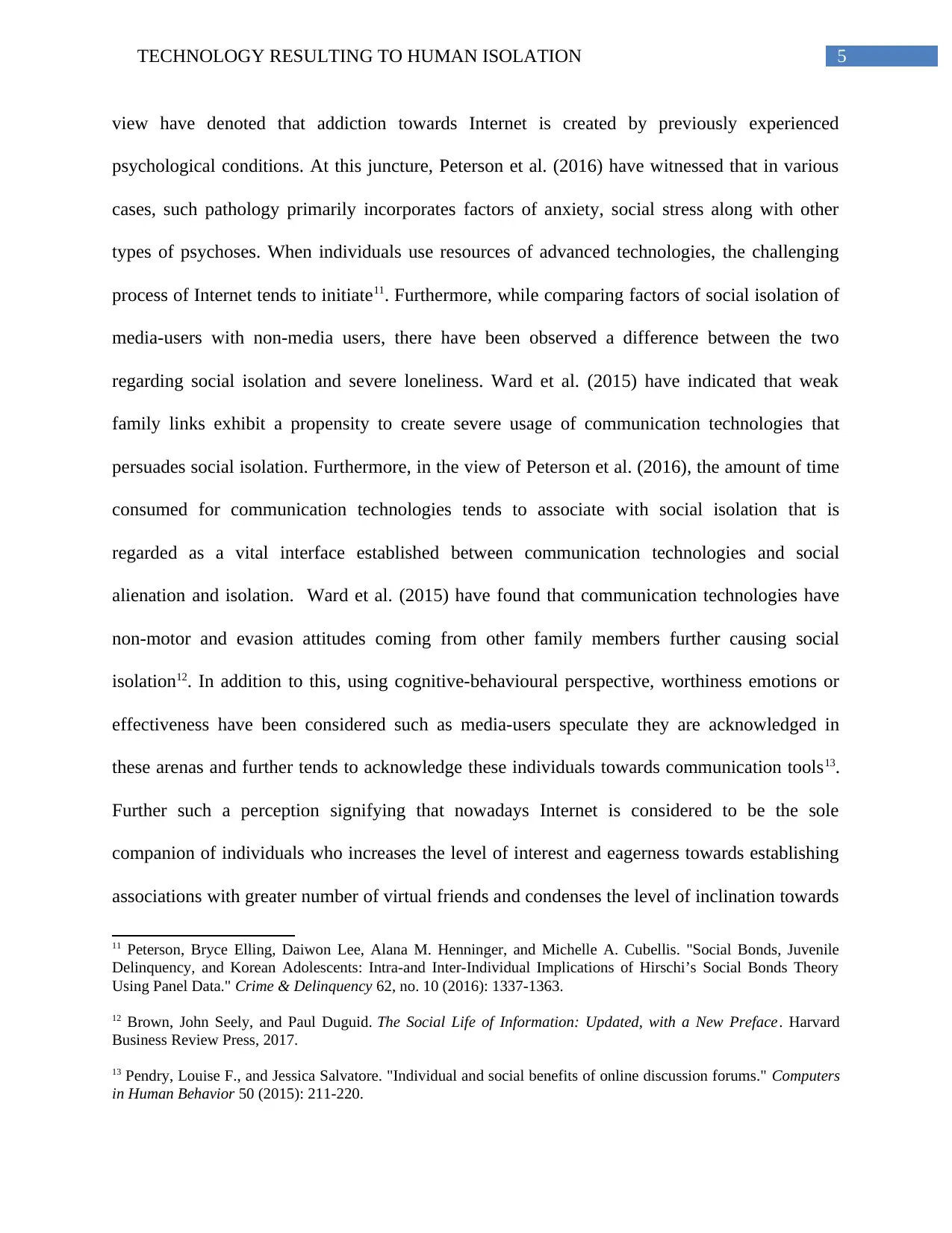
5TECHNOLOGY RESULTING TO HUMAN ISOLATION
view have denoted that addiction towards Internet is created by previously experienced
psychological conditions. At this juncture, Peterson et al. (2016) have witnessed that in various
cases, such pathology primarily incorporates factors of anxiety, social stress along with other
types of psychoses. When individuals use resources of advanced technologies, the challenging
process of Internet tends to initiate11. Furthermore, while comparing factors of social isolation of
media-users with non-media users, there have been observed a difference between the two
regarding social isolation and severe loneliness. Ward et al. (2015) have indicated that weak
family links exhibit a propensity to create severe usage of communication technologies that
persuades social isolation. Furthermore, in the view of Peterson et al. (2016), the amount of time
consumed for communication technologies tends to associate with social isolation that is
regarded as a vital interface established between communication technologies and social
alienation and isolation. Ward et al. (2015) have found that communication technologies have
non-motor and evasion attitudes coming from other family members further causing social
isolation12. In addition to this, using cognitive-behavioural perspective, worthiness emotions or
effectiveness have been considered such as media-users speculate they are acknowledged in
these arenas and further tends to acknowledge these individuals towards communication tools13.
Further such a perception signifying that nowadays Internet is considered to be the sole
companion of individuals who increases the level of interest and eagerness towards establishing
associations with greater number of virtual friends and condenses the level of inclination towards
11 Peterson, Bryce Elling, Daiwon Lee, Alana M. Henninger, and Michelle A. Cubellis. "Social Bonds, Juvenile
Delinquency, and Korean Adolescents: Intra-and Inter-Individual Implications of Hirschi’s Social Bonds Theory
Using Panel Data." Crime & Delinquency 62, no. 10 (2016): 1337-1363.
12 Brown, John Seely, and Paul Duguid. The Social Life of Information: Updated, with a New Preface. Harvard
Business Review Press, 2017.
13 Pendry, Louise F., and Jessica Salvatore. "Individual and social benefits of online discussion forums." Computers
in Human Behavior 50 (2015): 211-220.
view have denoted that addiction towards Internet is created by previously experienced
psychological conditions. At this juncture, Peterson et al. (2016) have witnessed that in various
cases, such pathology primarily incorporates factors of anxiety, social stress along with other
types of psychoses. When individuals use resources of advanced technologies, the challenging
process of Internet tends to initiate11. Furthermore, while comparing factors of social isolation of
media-users with non-media users, there have been observed a difference between the two
regarding social isolation and severe loneliness. Ward et al. (2015) have indicated that weak
family links exhibit a propensity to create severe usage of communication technologies that
persuades social isolation. Furthermore, in the view of Peterson et al. (2016), the amount of time
consumed for communication technologies tends to associate with social isolation that is
regarded as a vital interface established between communication technologies and social
alienation and isolation. Ward et al. (2015) have found that communication technologies have
non-motor and evasion attitudes coming from other family members further causing social
isolation12. In addition to this, using cognitive-behavioural perspective, worthiness emotions or
effectiveness have been considered such as media-users speculate they are acknowledged in
these arenas and further tends to acknowledge these individuals towards communication tools13.
Further such a perception signifying that nowadays Internet is considered to be the sole
companion of individuals who increases the level of interest and eagerness towards establishing
associations with greater number of virtual friends and condenses the level of inclination towards
11 Peterson, Bryce Elling, Daiwon Lee, Alana M. Henninger, and Michelle A. Cubellis. "Social Bonds, Juvenile
Delinquency, and Korean Adolescents: Intra-and Inter-Individual Implications of Hirschi’s Social Bonds Theory
Using Panel Data." Crime & Delinquency 62, no. 10 (2016): 1337-1363.
12 Brown, John Seely, and Paul Duguid. The Social Life of Information: Updated, with a New Preface. Harvard
Business Review Press, 2017.
13 Pendry, Louise F., and Jessica Salvatore. "Individual and social benefits of online discussion forums." Computers
in Human Behavior 50 (2015): 211-220.
⊘ This is a preview!⊘
Do you want full access?
Subscribe today to unlock all pages.

Trusted by 1+ million students worldwide
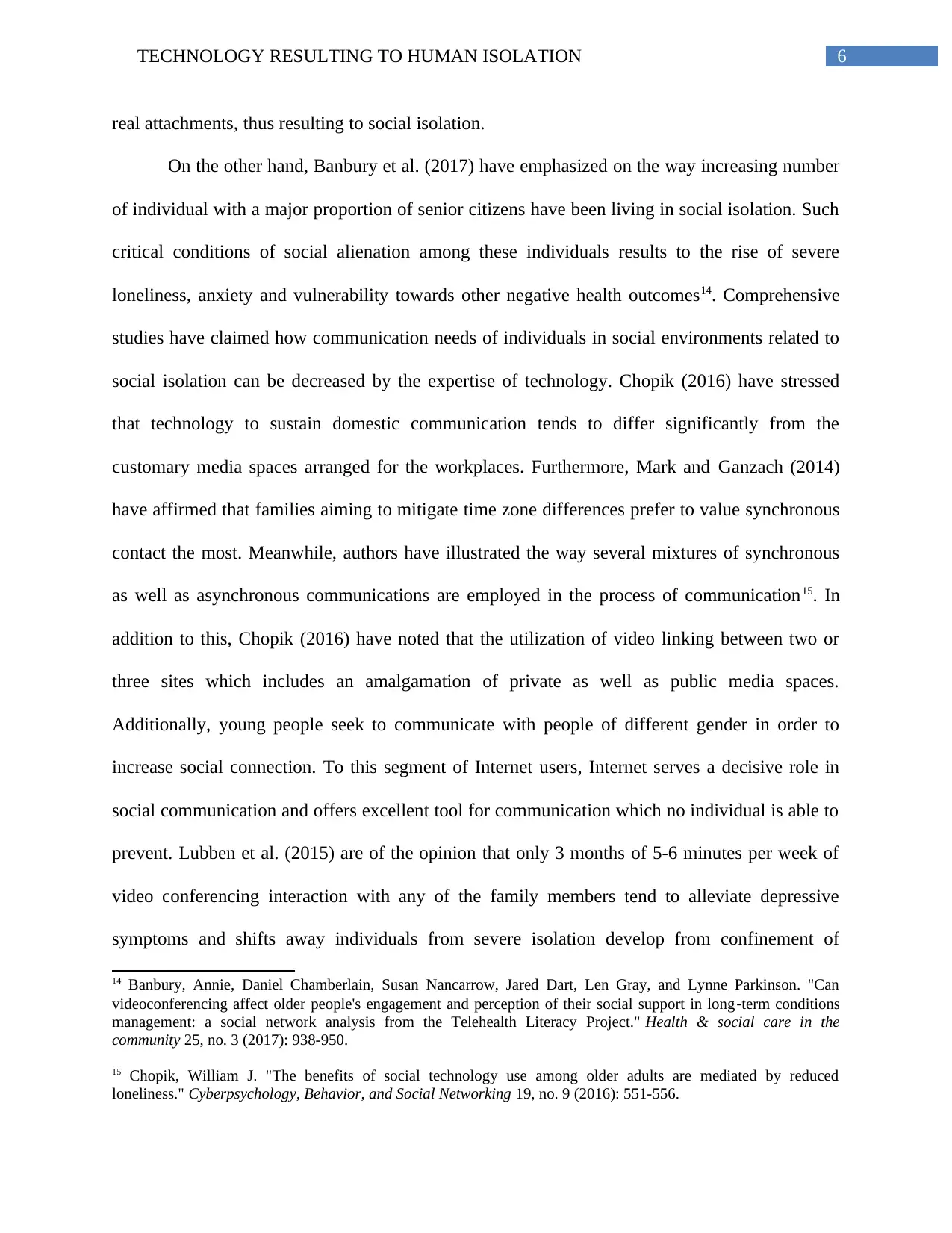
6TECHNOLOGY RESULTING TO HUMAN ISOLATION
real attachments, thus resulting to social isolation.
On the other hand, Banbury et al. (2017) have emphasized on the way increasing number
of individual with a major proportion of senior citizens have been living in social isolation. Such
critical conditions of social alienation among these individuals results to the rise of severe
loneliness, anxiety and vulnerability towards other negative health outcomes14. Comprehensive
studies have claimed how communication needs of individuals in social environments related to
social isolation can be decreased by the expertise of technology. Chopik (2016) have stressed
that technology to sustain domestic communication tends to differ significantly from the
customary media spaces arranged for the workplaces. Furthermore, Mark and Ganzach (2014)
have affirmed that families aiming to mitigate time zone differences prefer to value synchronous
contact the most. Meanwhile, authors have illustrated the way several mixtures of synchronous
as well as asynchronous communications are employed in the process of communication15. In
addition to this, Chopik (2016) have noted that the utilization of video linking between two or
three sites which includes an amalgamation of private as well as public media spaces.
Additionally, young people seek to communicate with people of different gender in order to
increase social connection. To this segment of Internet users, Internet serves a decisive role in
social communication and offers excellent tool for communication which no individual is able to
prevent. Lubben et al. (2015) are of the opinion that only 3 months of 5-6 minutes per week of
video conferencing interaction with any of the family members tend to alleviate depressive
symptoms and shifts away individuals from severe isolation develop from confinement of
14 Banbury, Annie, Daniel Chamberlain, Susan Nancarrow, Jared Dart, Len Gray, and Lynne Parkinson. "Can
videoconferencing affect older people's engagement and perception of their social support in long‐term conditions
management: a social network analysis from the Telehealth Literacy Project." Health & social care in the
community 25, no. 3 (2017): 938-950.
15 Chopik, William J. "The benefits of social technology use among older adults are mediated by reduced
loneliness." Cyberpsychology, Behavior, and Social Networking 19, no. 9 (2016): 551-556.
real attachments, thus resulting to social isolation.
On the other hand, Banbury et al. (2017) have emphasized on the way increasing number
of individual with a major proportion of senior citizens have been living in social isolation. Such
critical conditions of social alienation among these individuals results to the rise of severe
loneliness, anxiety and vulnerability towards other negative health outcomes14. Comprehensive
studies have claimed how communication needs of individuals in social environments related to
social isolation can be decreased by the expertise of technology. Chopik (2016) have stressed
that technology to sustain domestic communication tends to differ significantly from the
customary media spaces arranged for the workplaces. Furthermore, Mark and Ganzach (2014)
have affirmed that families aiming to mitigate time zone differences prefer to value synchronous
contact the most. Meanwhile, authors have illustrated the way several mixtures of synchronous
as well as asynchronous communications are employed in the process of communication15. In
addition to this, Chopik (2016) have noted that the utilization of video linking between two or
three sites which includes an amalgamation of private as well as public media spaces.
Additionally, young people seek to communicate with people of different gender in order to
increase social connection. To this segment of Internet users, Internet serves a decisive role in
social communication and offers excellent tool for communication which no individual is able to
prevent. Lubben et al. (2015) are of the opinion that only 3 months of 5-6 minutes per week of
video conferencing interaction with any of the family members tend to alleviate depressive
symptoms and shifts away individuals from severe isolation develop from confinement of
14 Banbury, Annie, Daniel Chamberlain, Susan Nancarrow, Jared Dart, Len Gray, and Lynne Parkinson. "Can
videoconferencing affect older people's engagement and perception of their social support in long‐term conditions
management: a social network analysis from the Telehealth Literacy Project." Health & social care in the
community 25, no. 3 (2017): 938-950.
15 Chopik, William J. "The benefits of social technology use among older adults are mediated by reduced
loneliness." Cyberpsychology, Behavior, and Social Networking 19, no. 9 (2016): 551-556.
Paraphrase This Document
Need a fresh take? Get an instant paraphrase of this document with our AI Paraphraser
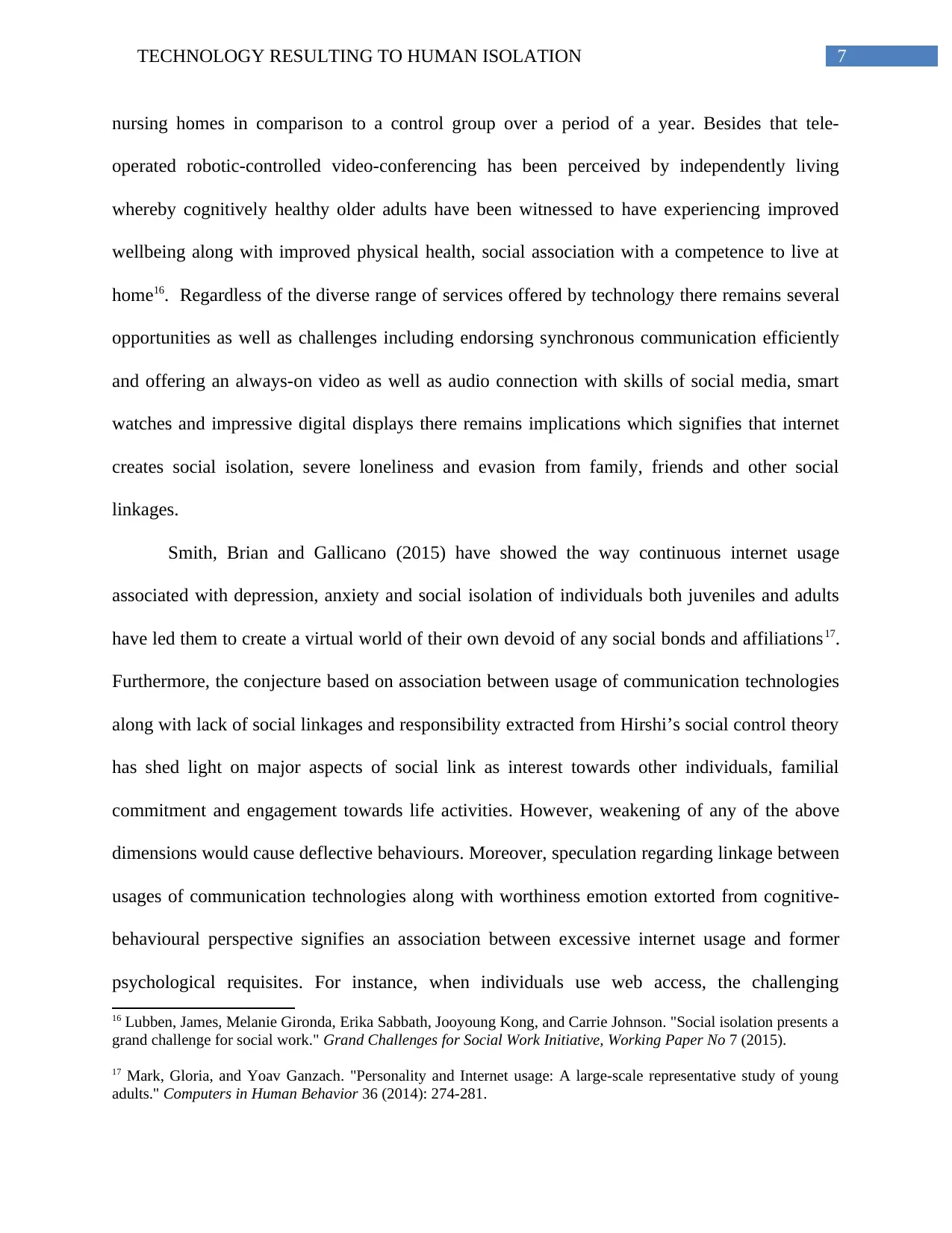
7TECHNOLOGY RESULTING TO HUMAN ISOLATION
nursing homes in comparison to a control group over a period of a year. Besides that tele-
operated robotic-controlled video-conferencing has been perceived by independently living
whereby cognitively healthy older adults have been witnessed to have experiencing improved
wellbeing along with improved physical health, social association with a competence to live at
home16. Regardless of the diverse range of services offered by technology there remains several
opportunities as well as challenges including endorsing synchronous communication efficiently
and offering an always-on video as well as audio connection with skills of social media, smart
watches and impressive digital displays there remains implications which signifies that internet
creates social isolation, severe loneliness and evasion from family, friends and other social
linkages.
Smith, Brian and Gallicano (2015) have showed the way continuous internet usage
associated with depression, anxiety and social isolation of individuals both juveniles and adults
have led them to create a virtual world of their own devoid of any social bonds and affiliations17.
Furthermore, the conjecture based on association between usage of communication technologies
along with lack of social linkages and responsibility extracted from Hirshi’s social control theory
has shed light on major aspects of social link as interest towards other individuals, familial
commitment and engagement towards life activities. However, weakening of any of the above
dimensions would cause deflective behaviours. Moreover, speculation regarding linkage between
usages of communication technologies along with worthiness emotion extorted from cognitive-
behavioural perspective signifies an association between excessive internet usage and former
psychological requisites. For instance, when individuals use web access, the challenging
16 Lubben, James, Melanie Gironda, Erika Sabbath, Jooyoung Kong, and Carrie Johnson. "Social isolation presents a
grand challenge for social work." Grand Challenges for Social Work Initiative, Working Paper No 7 (2015).
17 Mark, Gloria, and Yoav Ganzach. "Personality and Internet usage: A large-scale representative study of young
adults." Computers in Human Behavior 36 (2014): 274-281.
nursing homes in comparison to a control group over a period of a year. Besides that tele-
operated robotic-controlled video-conferencing has been perceived by independently living
whereby cognitively healthy older adults have been witnessed to have experiencing improved
wellbeing along with improved physical health, social association with a competence to live at
home16. Regardless of the diverse range of services offered by technology there remains several
opportunities as well as challenges including endorsing synchronous communication efficiently
and offering an always-on video as well as audio connection with skills of social media, smart
watches and impressive digital displays there remains implications which signifies that internet
creates social isolation, severe loneliness and evasion from family, friends and other social
linkages.
Smith, Brian and Gallicano (2015) have showed the way continuous internet usage
associated with depression, anxiety and social isolation of individuals both juveniles and adults
have led them to create a virtual world of their own devoid of any social bonds and affiliations17.
Furthermore, the conjecture based on association between usage of communication technologies
along with lack of social linkages and responsibility extracted from Hirshi’s social control theory
has shed light on major aspects of social link as interest towards other individuals, familial
commitment and engagement towards life activities. However, weakening of any of the above
dimensions would cause deflective behaviours. Moreover, speculation regarding linkage between
usages of communication technologies along with worthiness emotion extorted from cognitive-
behavioural perspective signifies an association between excessive internet usage and former
psychological requisites. For instance, when individuals use web access, the challenging
16 Lubben, James, Melanie Gironda, Erika Sabbath, Jooyoung Kong, and Carrie Johnson. "Social isolation presents a
grand challenge for social work." Grand Challenges for Social Work Initiative, Working Paper No 7 (2015).
17 Mark, Gloria, and Yoav Ganzach. "Personality and Internet usage: A large-scale representative study of young
adults." Computers in Human Behavior 36 (2014): 274-281.
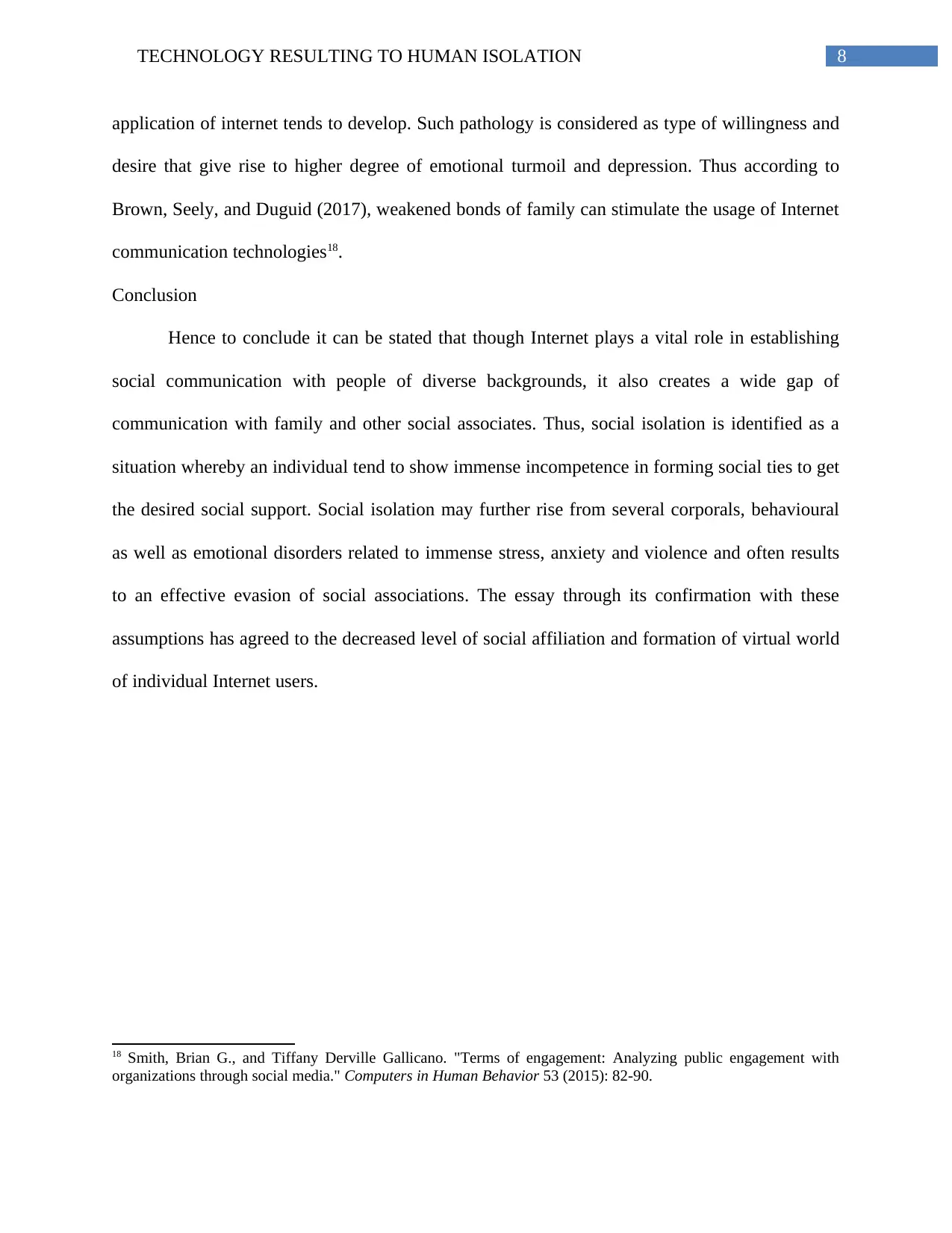
8TECHNOLOGY RESULTING TO HUMAN ISOLATION
application of internet tends to develop. Such pathology is considered as type of willingness and
desire that give rise to higher degree of emotional turmoil and depression. Thus according to
Brown, Seely, and Duguid (2017), weakened bonds of family can stimulate the usage of Internet
communication technologies18.
Conclusion
Hence to conclude it can be stated that though Internet plays a vital role in establishing
social communication with people of diverse backgrounds, it also creates a wide gap of
communication with family and other social associates. Thus, social isolation is identified as a
situation whereby an individual tend to show immense incompetence in forming social ties to get
the desired social support. Social isolation may further rise from several corporals, behavioural
as well as emotional disorders related to immense stress, anxiety and violence and often results
to an effective evasion of social associations. The essay through its confirmation with these
assumptions has agreed to the decreased level of social affiliation and formation of virtual world
of individual Internet users.
18 Smith, Brian G., and Tiffany Derville Gallicano. "Terms of engagement: Analyzing public engagement with
organizations through social media." Computers in Human Behavior 53 (2015): 82-90.
application of internet tends to develop. Such pathology is considered as type of willingness and
desire that give rise to higher degree of emotional turmoil and depression. Thus according to
Brown, Seely, and Duguid (2017), weakened bonds of family can stimulate the usage of Internet
communication technologies18.
Conclusion
Hence to conclude it can be stated that though Internet plays a vital role in establishing
social communication with people of diverse backgrounds, it also creates a wide gap of
communication with family and other social associates. Thus, social isolation is identified as a
situation whereby an individual tend to show immense incompetence in forming social ties to get
the desired social support. Social isolation may further rise from several corporals, behavioural
as well as emotional disorders related to immense stress, anxiety and violence and often results
to an effective evasion of social associations. The essay through its confirmation with these
assumptions has agreed to the decreased level of social affiliation and formation of virtual world
of individual Internet users.
18 Smith, Brian G., and Tiffany Derville Gallicano. "Terms of engagement: Analyzing public engagement with
organizations through social media." Computers in Human Behavior 53 (2015): 82-90.
⊘ This is a preview!⊘
Do you want full access?
Subscribe today to unlock all pages.

Trusted by 1+ million students worldwide
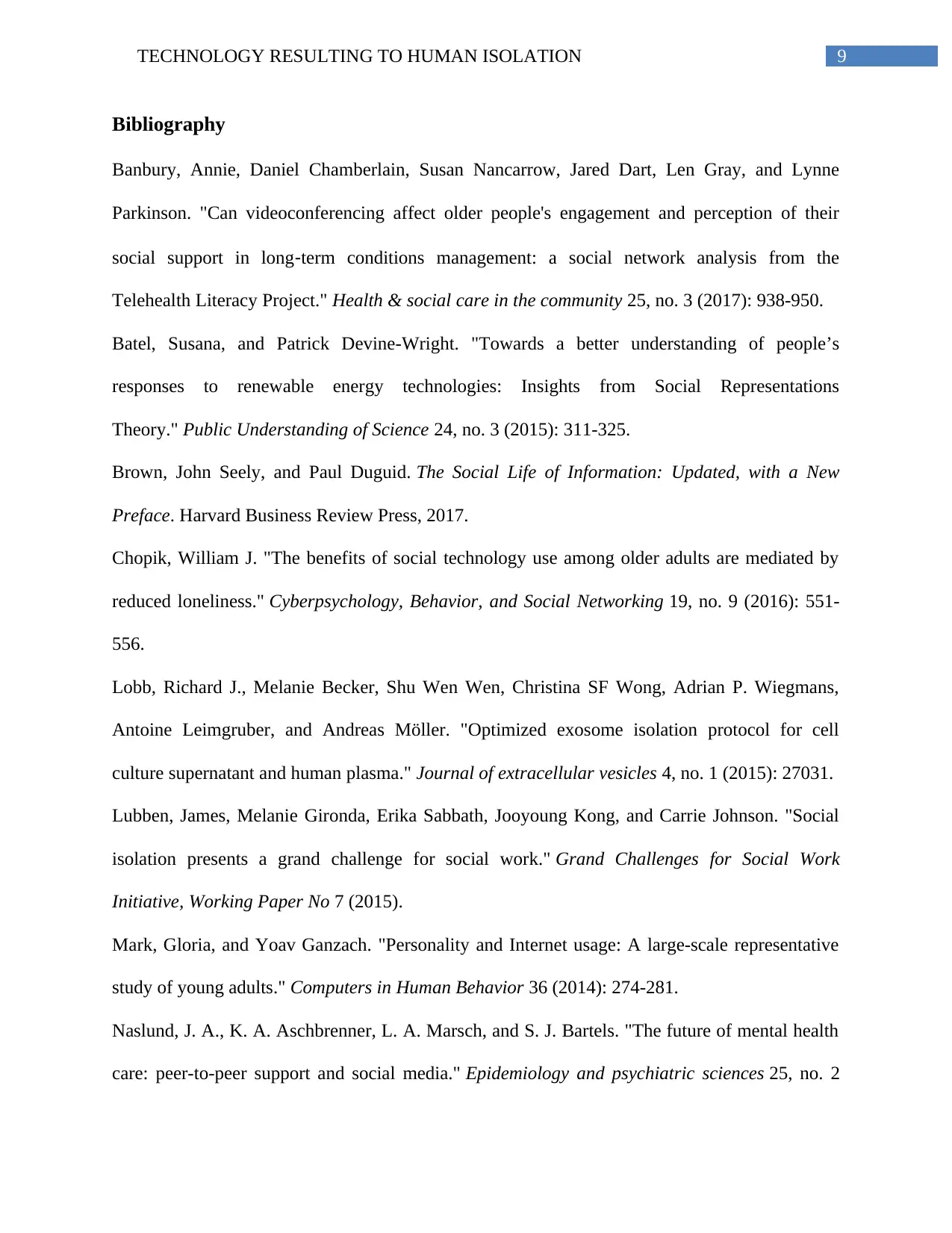
9TECHNOLOGY RESULTING TO HUMAN ISOLATION
Bibliography
Banbury, Annie, Daniel Chamberlain, Susan Nancarrow, Jared Dart, Len Gray, and Lynne
Parkinson. "Can videoconferencing affect older people's engagement and perception of their
social support in long‐term conditions management: a social network analysis from the
Telehealth Literacy Project." Health & social care in the community 25, no. 3 (2017): 938-950.
Batel, Susana, and Patrick Devine-Wright. "Towards a better understanding of people’s
responses to renewable energy technologies: Insights from Social Representations
Theory." Public Understanding of Science 24, no. 3 (2015): 311-325.
Brown, John Seely, and Paul Duguid. The Social Life of Information: Updated, with a New
Preface. Harvard Business Review Press, 2017.
Chopik, William J. "The benefits of social technology use among older adults are mediated by
reduced loneliness." Cyberpsychology, Behavior, and Social Networking 19, no. 9 (2016): 551-
556.
Lobb, Richard J., Melanie Becker, Shu Wen Wen, Christina SF Wong, Adrian P. Wiegmans,
Antoine Leimgruber, and Andreas Möller. "Optimized exosome isolation protocol for cell
culture supernatant and human plasma." Journal of extracellular vesicles 4, no. 1 (2015): 27031.
Lubben, James, Melanie Gironda, Erika Sabbath, Jooyoung Kong, and Carrie Johnson. "Social
isolation presents a grand challenge for social work." Grand Challenges for Social Work
Initiative, Working Paper No 7 (2015).
Mark, Gloria, and Yoav Ganzach. "Personality and Internet usage: A large-scale representative
study of young adults." Computers in Human Behavior 36 (2014): 274-281.
Naslund, J. A., K. A. Aschbrenner, L. A. Marsch, and S. J. Bartels. "The future of mental health
care: peer-to-peer support and social media." Epidemiology and psychiatric sciences 25, no. 2
Bibliography
Banbury, Annie, Daniel Chamberlain, Susan Nancarrow, Jared Dart, Len Gray, and Lynne
Parkinson. "Can videoconferencing affect older people's engagement and perception of their
social support in long‐term conditions management: a social network analysis from the
Telehealth Literacy Project." Health & social care in the community 25, no. 3 (2017): 938-950.
Batel, Susana, and Patrick Devine-Wright. "Towards a better understanding of people’s
responses to renewable energy technologies: Insights from Social Representations
Theory." Public Understanding of Science 24, no. 3 (2015): 311-325.
Brown, John Seely, and Paul Duguid. The Social Life of Information: Updated, with a New
Preface. Harvard Business Review Press, 2017.
Chopik, William J. "The benefits of social technology use among older adults are mediated by
reduced loneliness." Cyberpsychology, Behavior, and Social Networking 19, no. 9 (2016): 551-
556.
Lobb, Richard J., Melanie Becker, Shu Wen Wen, Christina SF Wong, Adrian P. Wiegmans,
Antoine Leimgruber, and Andreas Möller. "Optimized exosome isolation protocol for cell
culture supernatant and human plasma." Journal of extracellular vesicles 4, no. 1 (2015): 27031.
Lubben, James, Melanie Gironda, Erika Sabbath, Jooyoung Kong, and Carrie Johnson. "Social
isolation presents a grand challenge for social work." Grand Challenges for Social Work
Initiative, Working Paper No 7 (2015).
Mark, Gloria, and Yoav Ganzach. "Personality and Internet usage: A large-scale representative
study of young adults." Computers in Human Behavior 36 (2014): 274-281.
Naslund, J. A., K. A. Aschbrenner, L. A. Marsch, and S. J. Bartels. "The future of mental health
care: peer-to-peer support and social media." Epidemiology and psychiatric sciences 25, no. 2
Paraphrase This Document
Need a fresh take? Get an instant paraphrase of this document with our AI Paraphraser
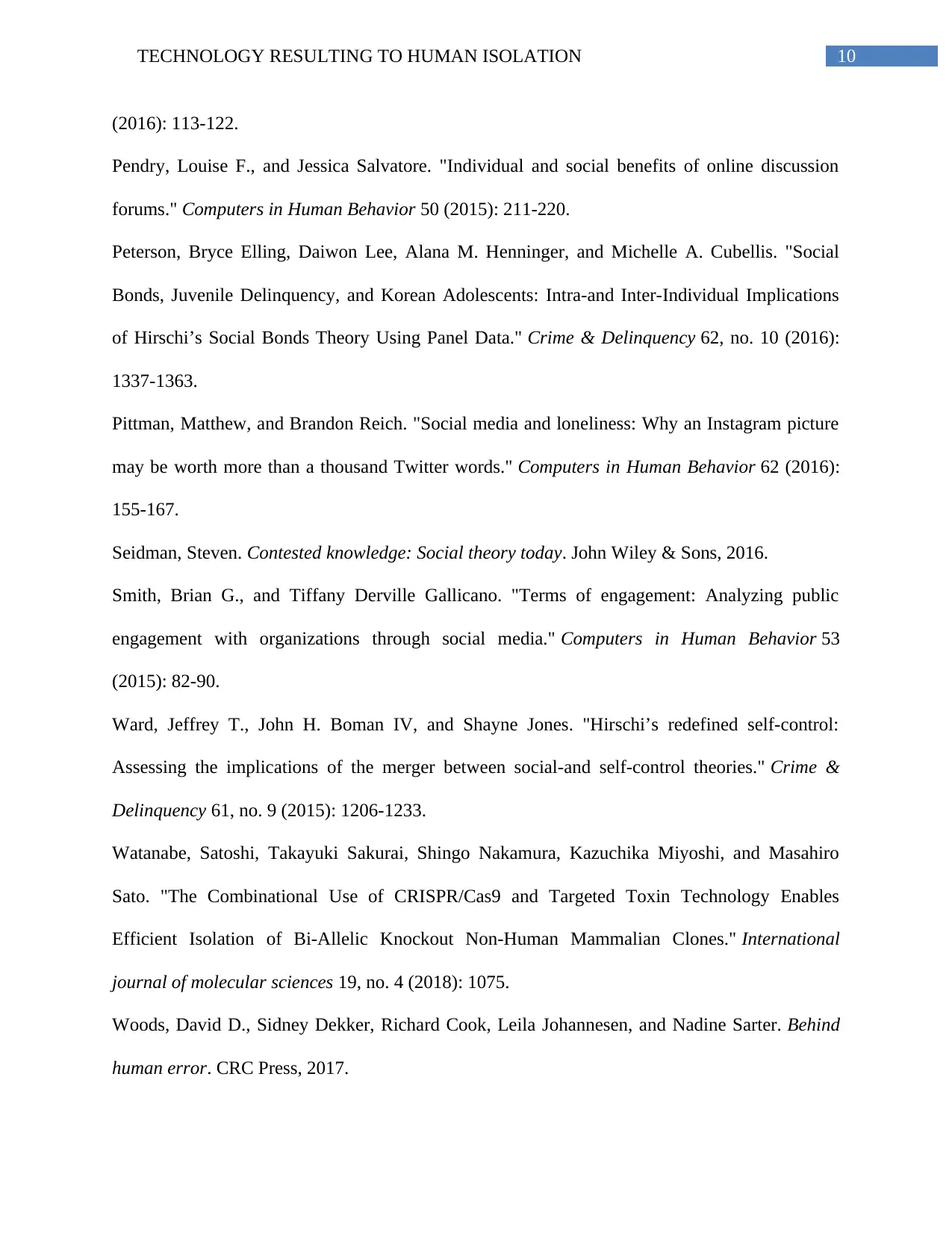
10TECHNOLOGY RESULTING TO HUMAN ISOLATION
(2016): 113-122.
Pendry, Louise F., and Jessica Salvatore. "Individual and social benefits of online discussion
forums." Computers in Human Behavior 50 (2015): 211-220.
Peterson, Bryce Elling, Daiwon Lee, Alana M. Henninger, and Michelle A. Cubellis. "Social
Bonds, Juvenile Delinquency, and Korean Adolescents: Intra-and Inter-Individual Implications
of Hirschi’s Social Bonds Theory Using Panel Data." Crime & Delinquency 62, no. 10 (2016):
1337-1363.
Pittman, Matthew, and Brandon Reich. "Social media and loneliness: Why an Instagram picture
may be worth more than a thousand Twitter words." Computers in Human Behavior 62 (2016):
155-167.
Seidman, Steven. Contested knowledge: Social theory today. John Wiley & Sons, 2016.
Smith, Brian G., and Tiffany Derville Gallicano. "Terms of engagement: Analyzing public
engagement with organizations through social media." Computers in Human Behavior 53
(2015): 82-90.
Ward, Jeffrey T., John H. Boman IV, and Shayne Jones. "Hirschi’s redefined self-control:
Assessing the implications of the merger between social-and self-control theories." Crime &
Delinquency 61, no. 9 (2015): 1206-1233.
Watanabe, Satoshi, Takayuki Sakurai, Shingo Nakamura, Kazuchika Miyoshi, and Masahiro
Sato. "The Combinational Use of CRISPR/Cas9 and Targeted Toxin Technology Enables
Efficient Isolation of Bi-Allelic Knockout Non-Human Mammalian Clones." International
journal of molecular sciences 19, no. 4 (2018): 1075.
Woods, David D., Sidney Dekker, Richard Cook, Leila Johannesen, and Nadine Sarter. Behind
human error. CRC Press, 2017.
(2016): 113-122.
Pendry, Louise F., and Jessica Salvatore. "Individual and social benefits of online discussion
forums." Computers in Human Behavior 50 (2015): 211-220.
Peterson, Bryce Elling, Daiwon Lee, Alana M. Henninger, and Michelle A. Cubellis. "Social
Bonds, Juvenile Delinquency, and Korean Adolescents: Intra-and Inter-Individual Implications
of Hirschi’s Social Bonds Theory Using Panel Data." Crime & Delinquency 62, no. 10 (2016):
1337-1363.
Pittman, Matthew, and Brandon Reich. "Social media and loneliness: Why an Instagram picture
may be worth more than a thousand Twitter words." Computers in Human Behavior 62 (2016):
155-167.
Seidman, Steven. Contested knowledge: Social theory today. John Wiley & Sons, 2016.
Smith, Brian G., and Tiffany Derville Gallicano. "Terms of engagement: Analyzing public
engagement with organizations through social media." Computers in Human Behavior 53
(2015): 82-90.
Ward, Jeffrey T., John H. Boman IV, and Shayne Jones. "Hirschi’s redefined self-control:
Assessing the implications of the merger between social-and self-control theories." Crime &
Delinquency 61, no. 9 (2015): 1206-1233.
Watanabe, Satoshi, Takayuki Sakurai, Shingo Nakamura, Kazuchika Miyoshi, and Masahiro
Sato. "The Combinational Use of CRISPR/Cas9 and Targeted Toxin Technology Enables
Efficient Isolation of Bi-Allelic Knockout Non-Human Mammalian Clones." International
journal of molecular sciences 19, no. 4 (2018): 1075.
Woods, David D., Sidney Dekker, Richard Cook, Leila Johannesen, and Nadine Sarter. Behind
human error. CRC Press, 2017.
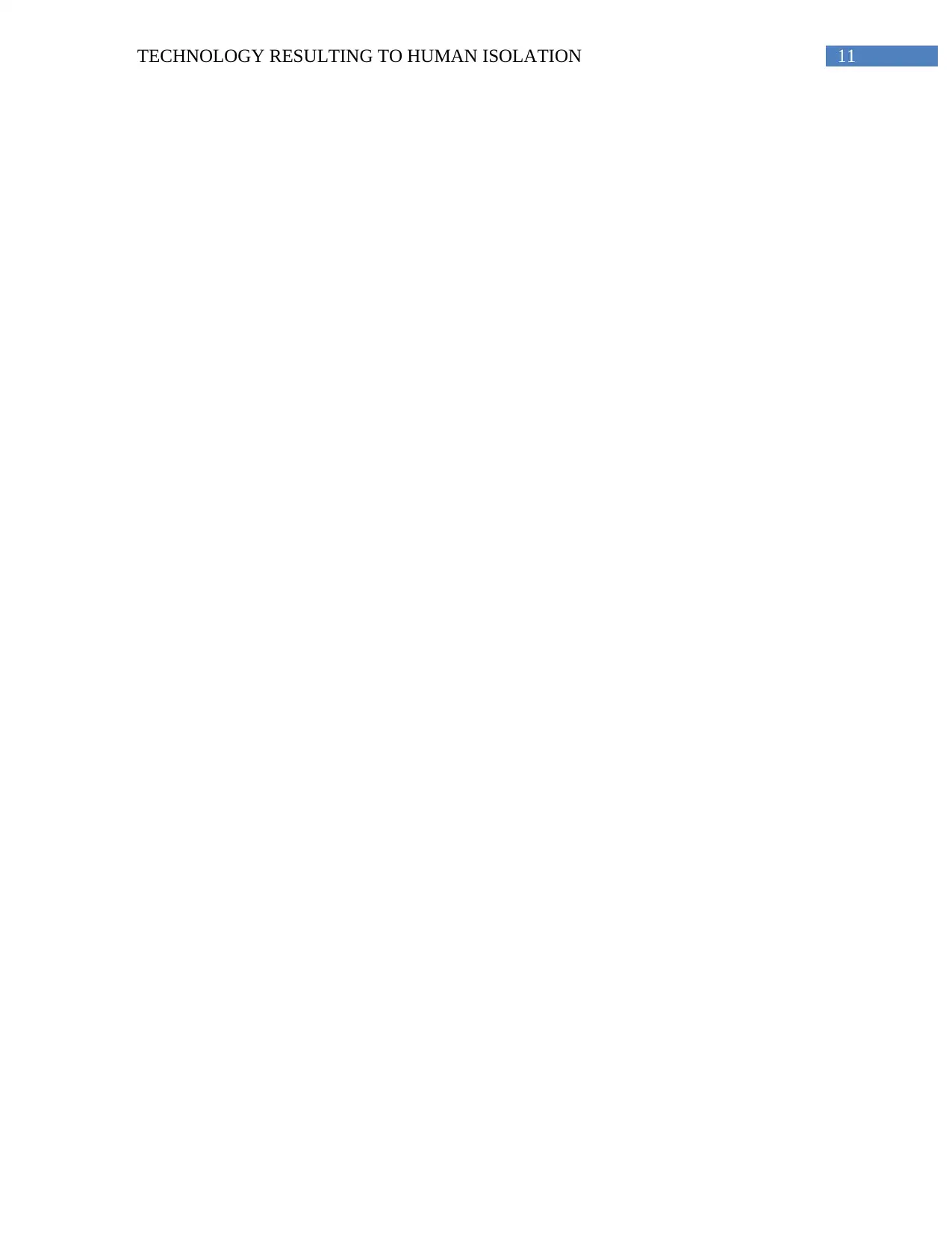
11TECHNOLOGY RESULTING TO HUMAN ISOLATION
⊘ This is a preview!⊘
Do you want full access?
Subscribe today to unlock all pages.

Trusted by 1+ million students worldwide
1 out of 12
Related Documents
Your All-in-One AI-Powered Toolkit for Academic Success.
+13062052269
info@desklib.com
Available 24*7 on WhatsApp / Email
![[object Object]](/_next/static/media/star-bottom.7253800d.svg)
Unlock your academic potential
Copyright © 2020–2025 A2Z Services. All Rights Reserved. Developed and managed by ZUCOL.




